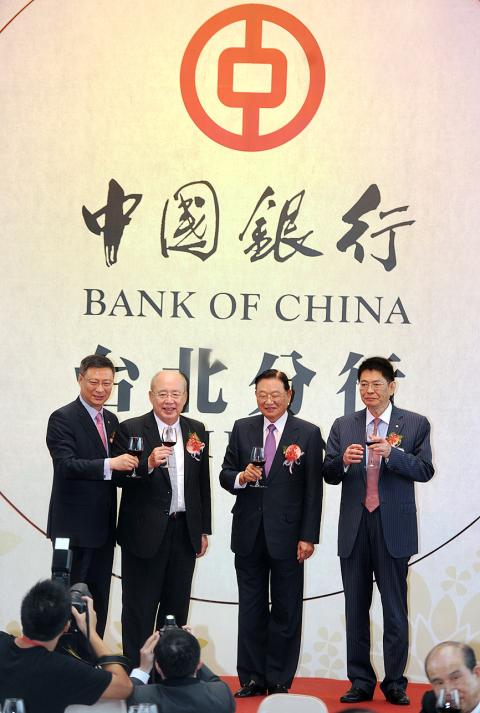Bank of China (中國銀行), the first Chinese lender to set up a branch in Taiwan, aims to forge closer ties with Taiwanese firms with operations in China, including offers of yuan settlement services once Taipei and Beijing work out a mechanism, the lender’s president Li Lihui (李禮輝) said yesterday.
Li, who hosted the official opening of the branch in Taipei, said he met with officials at the central bank and the Financial Supervisory Commission for talks on business development plans.
“As a commercial bank, we hope the two sides can promptly set up a currency settlement mechanism,” Li told a media briefing.

WARNING: EXCESSIVE CONSUMPTION OF ALCOHOL CAN DAMAGE YOUR HEALTH
Photo: Liao Chen-hui, Taipei Times
Bank of China is the world’s top provider of yuan settlement services, which amounted to 803 billion yuan (US$126 billion) for the first five months of the year, Li said.
“We are the main [yuan] settlement bank in Hong Kong, Macau and Malaysia and we hope to extend the services to Taipei once regulatory barriers are removed,” he said.
With cross-strait trade valued at US$160 billion last year and Taiwan’s trade surplus totaling US$89.8 billion, yuan settlement would save Taiwanese firms with cross-strait operations significant foreign-exchange costs and allow them to better control foreign-exchange risks, Li said.
Currently, only designated banking units can conduct yuan exchanges, but they cannot take yuan deposits or provide yuan loans. Further, domestic lenders may provide yuan-related business for corporate clients through their offshore banking units.
The designated banking units have to go through either Bank of Taiwan (台灣銀行) or Mega International Commercial Bank (兆豐銀行) for currency settlements with Bank of China in Hong Kong.
Li said Bank of China plans to provide over 200 billion yuan to help Taiwanese firms expand in China in the next three years.
Potential borrowers are Taiwanese firms that can advance China’s development plans and meet lending criteria, he said.
Li said the Taipei branch would keep close contact with the headquarters of Taiwanese firms with operations in China so the lender can better mobilize its global resources to strengthen services.

Shares in Taiwan closed at a new high yesterday, the first trading day of the new year, as contract chipmaker Taiwan Semiconductor Manufacturing Co (TSMC, 台積電) continued to break records amid an artificial intelligence (AI) boom, dealers said. The TAIEX closed up 386.21 points, or 1.33 percent, at 29,349.81, with turnover totaling NT$648.844 billion (US$20.65 billion). “Judging from a stronger Taiwan dollar against the US dollar, I think foreign institutional investors returned from the holidays and brought funds into the local market,” Concord Securities Co (康和證券) analyst Kerry Huang (黃志祺) said. “Foreign investors just rebuilt their positions with TSMC as their top target,

REVENUE PERFORMANCE: Cloud and network products, and electronic components saw strong increases, while smart consumer electronics and computing products fell Hon Hai Precision Industry Co (鴻海精密) yesterday posted 26.51 percent quarterly growth in revenue for last quarter to NT$2.6 trillion (US$82.44 billion), the strongest on record for the period and above expectations, but the company forecast a slight revenue dip this quarter due to seasonal factors. On an annual basis, revenue last quarter grew 22.07 percent, the company said. Analysts on average estimated about NT$2.4 trillion increase. Hon Hai, which assembles servers for Nvidia Corp and iPhones for Apple Inc, is expanding its capacity in the US, adding artificial intelligence (AI) server production in Wisconsin and Texas, where it operates established campuses. This

H200 CHIPS: A source said that Nvidia has asked the Taiwanese company to begin production of additional chips and work is expected to start in the second quarter Nvidia Corp is scrambling to meet demand for its H200 artificial intelligence (AI) chips from Chinese technology companies and has approached contract manufacturer Taiwan Semiconductor Manufacturing Co (TSMC, 台積電) to ramp up production, sources said. Chinese technology companies have placed orders for more than 2 million H200 chips for this year, while Nvidia holds just 700,000 units in stock, two of the people said. The exact additional volume Nvidia intends to order from TSMC remains unclear, they said. A third source said that Nvidia has asked TSMC to begin production of the additional chips and work is expected to start in the second

Garment maker Makalot Industrial Co (聚陽) yesterday reported lower-than-expected fourth-quarter revenue of NT$7.93 billion (US$251.44 million), down 9.48 percent from NT$8.76 billion a year earlier. On a quarterly basis, revenue fell 10.83 percent from NT$8.89 billion, company data showed. The figure was also lower than market expectations of NT$8.05 billion, according to data compiled by Yuanta Securities Investment and Consulting Co (元大投顧), which had projected NT$8.22 billion. Makalot’s revenue this quarter would likely increase by a mid-teens percentage as the industry is entering its high season, Yuanta said. Overall, Makalot’s revenue last year totaled NT$34.43 billion, down 3.08 percent from its record NT$35.52